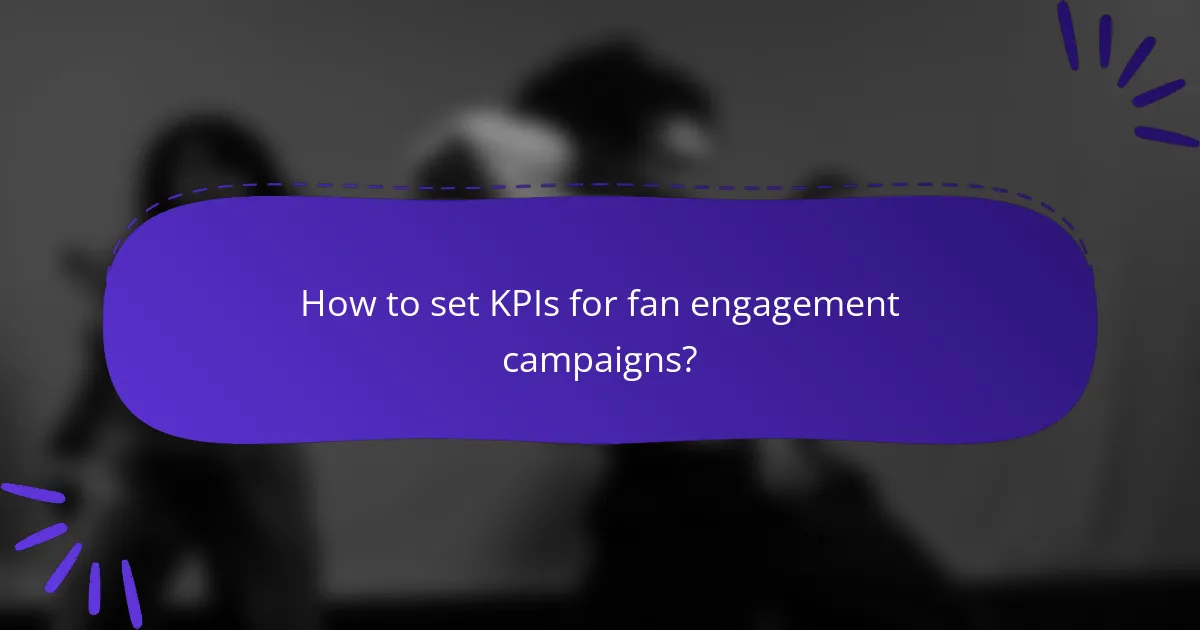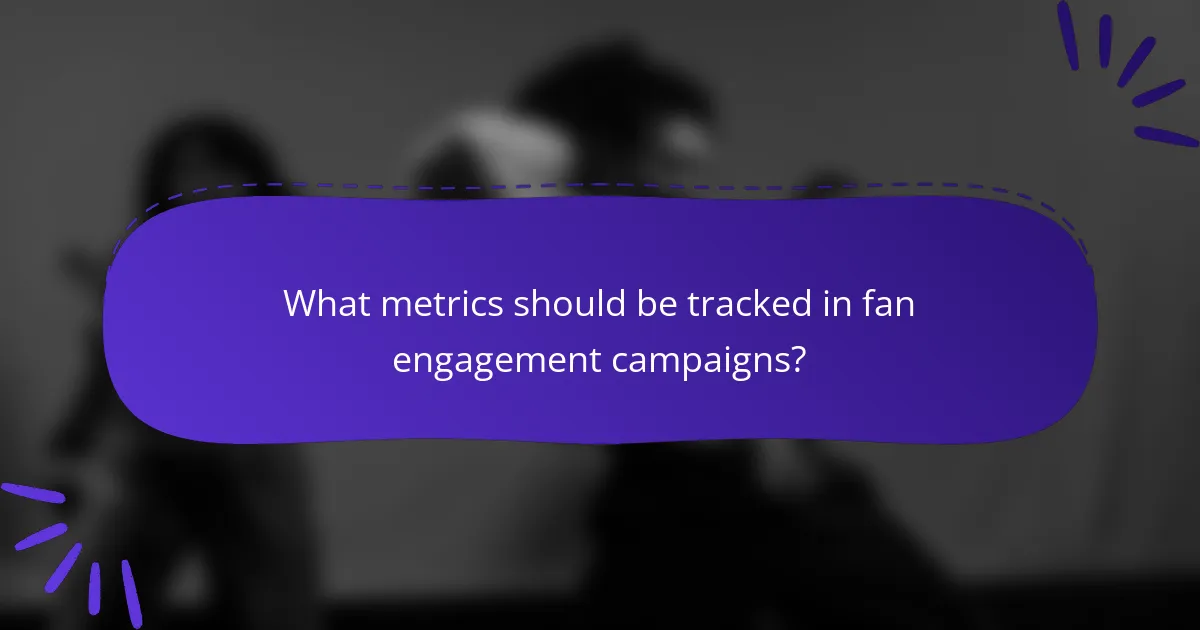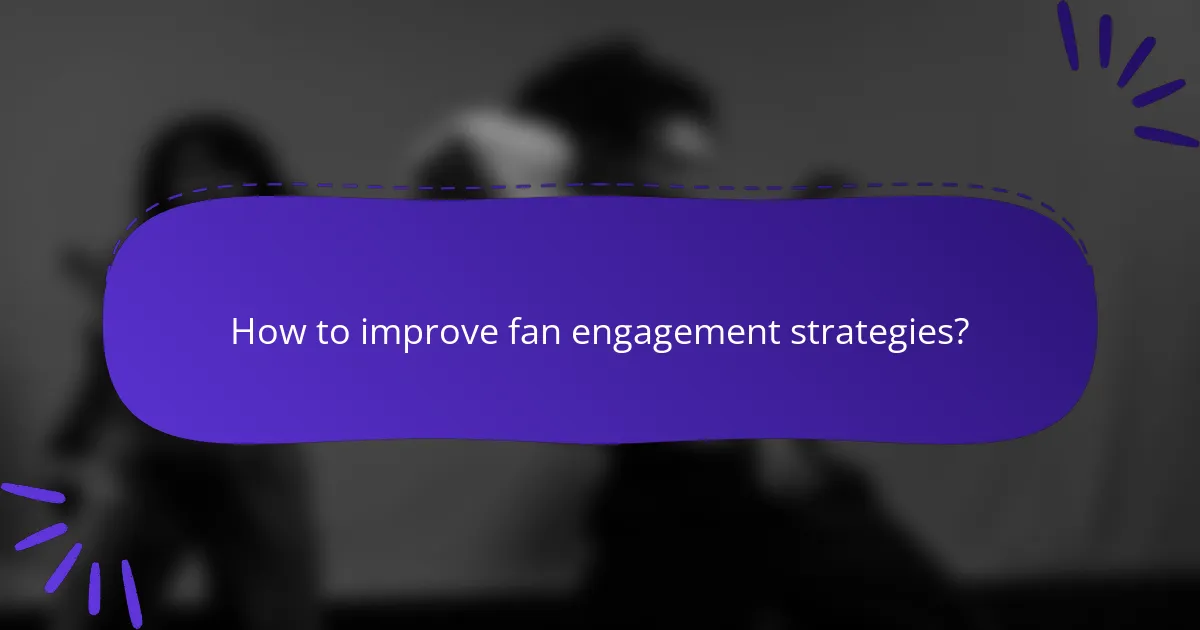Fan engagement campaigns are essential for building lasting relationships with audiences, and setting clear KPIs is the first step in measuring their success. By identifying specific metrics that align with your objectives, you can gain valuable insights into fan interactions and satisfaction. Tracking these metrics allows for a comprehensive analysis of campaign effectiveness, guiding future improvements and strategies.

How to set KPIs for fan engagement campaigns?
Setting KPIs for fan engagement campaigns involves identifying measurable indicators that reflect the success of your initiatives. These metrics should align with your overall objectives and provide insights into fan interactions and satisfaction.
Define specific engagement goals
Specific engagement goals clarify what you want to achieve with your campaign. For example, you might aim to increase social media interactions by a certain percentage or boost event attendance. Clearly defined goals help in measuring progress and success.
Consider using metrics like the number of shares, comments, or likes on social media platforms, or tracking attendance numbers at events. Specificity allows for better focus and resource allocation.
Utilize SMART criteria
Applying SMART criteria—Specific, Measurable, Achievable, Relevant, and Time-bound—ensures your KPIs are effective. For instance, instead of a vague goal like “increase fan engagement,” specify “increase social media engagement by 20% over the next three months.”
This approach helps in creating realistic targets that can be tracked and assessed over time. Regularly review these metrics to ensure they remain relevant to your campaign’s evolving objectives.
Align KPIs with business objectives
Your KPIs should directly support your broader business objectives. If your goal is to enhance brand loyalty, consider metrics that reflect repeat interactions, such as return visits to your website or app. Aligning these indicators ensures that your fan engagement efforts contribute to overall business success.
For example, if a sports team aims to increase merchandise sales, KPIs could include tracking the number of fans engaging with promotional content or attending games. This alignment creates a cohesive strategy across all levels of the organization.
Incorporate fan feedback mechanisms
Integrating fan feedback mechanisms is crucial for understanding audience sentiment and preferences. Surveys, polls, and social media listening tools can provide valuable insights into what fans enjoy or want improved.
Regularly collect and analyze this feedback to adjust your KPIs as needed. For instance, if fans express a desire for more interactive content, you might shift your focus to engagement metrics that reflect this change, such as participation in live Q&A sessions or fan polls.

What metrics should be tracked in fan engagement campaigns?
Tracking the right metrics in fan engagement campaigns is crucial for understanding their effectiveness and impact. Key metrics include social media interactions, email open and click rates, event attendance, and website traffic, each providing insights into different aspects of fan engagement.
Social media interactions
Social media interactions measure how fans engage with content on platforms like Facebook, Twitter, and Instagram. Key indicators include likes, shares, comments, and mentions, which reflect the level of interest and connection fans feel towards the brand or event.
To effectively track social media interactions, set specific goals for each campaign, such as increasing engagement by a certain percentage. Tools like Hootsuite or Sprout Social can help analyze these metrics and identify trends over time.
Email open and click rates
Email open and click rates are essential for assessing the effectiveness of email marketing efforts in fan engagement. The open rate indicates how many recipients opened the email, while the click rate shows how many clicked on links within the email.
Aim for an open rate between 20-30% and a click rate of around 2-5% for successful campaigns. Use A/B testing to optimize subject lines and content, and segment your audience to tailor messages for better engagement.
Event attendance and participation
Event attendance and participation metrics provide insights into how well fans are engaging with live events or virtual gatherings. Tracking the number of attendees, ticket sales, and participation in activities can help gauge interest and satisfaction.
Consider using surveys post-event to gather feedback and measure overall satisfaction. Aim for a target attendance rate based on previous events, and analyze factors that contributed to higher or lower participation.
Website traffic and conversion rates
Website traffic and conversion rates are critical for understanding how effectively your online presence drives fan engagement. Traffic metrics show how many visitors are coming to your site, while conversion rates indicate how many of those visitors take desired actions, such as signing up for newsletters or purchasing merchandise.
Utilize tools like Google Analytics to monitor these metrics. A good conversion rate typically ranges from 1-3%, depending on the industry. Focus on optimizing user experience and content to improve both traffic and conversions.

How to analyze outcomes of fan engagement campaigns?
Analyzing the outcomes of fan engagement campaigns involves assessing various metrics to determine their effectiveness. This process helps identify strengths, weaknesses, and areas for improvement to enhance future campaigns.
Evaluate against established KPIs
Evaluating fan engagement campaigns against established Key Performance Indicators (KPIs) is crucial for understanding their success. Common KPIs include engagement rates, conversion rates, and audience growth, which provide a quantitative basis for analysis.
To effectively evaluate, set specific, measurable targets before launching the campaign. For example, aim for a 20% increase in social media engagement or a 15% rise in newsletter sign-ups. Regularly compare actual results against these benchmarks to gauge performance.
Conduct sentiment analysis
Sentiment analysis involves assessing fan reactions and feelings towards your campaigns, often through social media monitoring and surveys. This qualitative data can reveal how fans perceive your brand and its initiatives.
Utilize tools that analyze social media mentions and comments to gauge overall sentiment. Look for trends in positive, negative, and neutral feedback. For instance, if a campaign receives a high volume of positive comments, it indicates strong fan approval, while negative feedback may highlight areas needing improvement.
Measure ROI on marketing spend
Measuring the Return on Investment (ROI) for marketing spend is essential to understand the financial effectiveness of fan engagement campaigns. Calculate ROI by comparing the revenue generated from the campaign to the costs incurred.
A simple formula to calculate ROI is: (Net Profit / Cost of Investment) x 100. For example, if a campaign costs $10,000 and generates $30,000 in revenue, the ROI would be 200%. Aim for a positive ROI to ensure that your marketing efforts are financially viable.
![]()
What tools can assist in tracking fan engagement metrics?
Several tools can effectively track fan engagement metrics, helping organizations understand their audience better. Utilizing the right platforms allows for comprehensive analysis of website traffic, social media interactions, and email campaign performance.
Google Analytics for website traffic
Google Analytics is a powerful tool for monitoring website traffic and user behavior. It provides insights into how fans interact with your site, including page views, session duration, and bounce rates. This data helps identify which content resonates most with your audience.
To make the most of Google Analytics, set up goals that align with your fan engagement objectives, such as newsletter sign-ups or merchandise purchases. Regularly review your reports to track trends and adjust your strategies accordingly.
Hootsuite for social media metrics
Hootsuite is an excellent platform for analyzing social media metrics across various channels. It allows you to track engagement rates, follower growth, and post performance, providing a clear picture of how fans interact with your brand online.
To enhance your social media strategy, use Hootsuite’s analytics to identify peak engagement times and popular content types. This information can guide your posting schedule and content creation, ensuring you connect with your audience effectively.
Mailchimp for email campaign performance
Mailchimp is widely used for managing email campaigns and tracking their performance. It offers metrics such as open rates, click-through rates, and conversion rates, which are crucial for understanding how fans respond to your communications.
To optimize your email campaigns, segment your audience based on their engagement levels and tailor your content accordingly. Regularly analyze your Mailchimp reports to refine your messaging and improve overall engagement.

How to improve fan engagement strategies?
Improving fan engagement strategies involves understanding your audience and utilizing effective methods to connect with them. Focus on creating personalized experiences, leveraging technology, and measuring outcomes to refine your approach.
Leverage data analytics for insights
Data analytics plays a crucial role in enhancing fan engagement by providing insights into fan behavior and preferences. By analyzing data from various sources, such as social media interactions, ticket sales, and website traffic, organizations can identify trends and tailor their strategies accordingly.
Consider using tools like Google Analytics or social media analytics platforms to track engagement metrics. Key performance indicators (KPIs) such as engagement rates, conversion rates, and audience demographics can guide your decision-making process. For example, if data shows a spike in engagement during specific events, you can plan more activities around those times.
To effectively leverage data, ensure you have a clear strategy for collecting and analyzing information. Avoid common pitfalls like overcomplicating data interpretation or neglecting to act on insights. Regularly review your analytics to adapt your engagement strategies and maintain a strong connection with your fan base.


